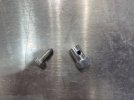Electric Parking Brake
I really didn’t want a hand brake taking up space in an already crowded interior and I had read in multiple build logs that they don’t work very well.
Therefore, I decided to go with an electric parking brake system. I looked at the available offering such as the E-Stopp, but they are too long to fit so I put together a bespoke electric parking brake system. The whole system cost about $130 on Amazon, but $32 of that was shipping.
I used two 25mm linear actuators mounted inside the engine surround, one for each side, anchored to the lower bulkhead. The cables are from the RCR kit, but shortened to about three feet. The brake is activated/deactivated with a Forward and Reverse Relay Module and a Latching Push Button Switch.
My first step was to install the actuator anchors. I chose an anchor location that avoids interference with the lower suspension link and provides a fairly direct cable path.
I used a wooden block as a drill guide for the anchor mounting. I drilled the block using one of the provided anchor brackets as a template. I then clamped the block to the bulkhead positioned such that the bottom inboard hole is 6-1/4” from top edge and 2-1/8” from tub wall. My goal was to allow for access while avoiding blocking the opening and associated cover fasteners. I also wanted enough space to drill the holes. I used an air drill because it has a small head. I made sure there was enough room inside the tub surround to insert the bolts and reach up to insert the cotter pin through the anchor pin. Note that the wall inside the engine surround is doubled so there is 1/4” less space between the bracket and wall than as measured in the passenger area. I drilled out the anchor bracket holes to 5/16” so I wouldn’t have to fight too hard to insert the bolts in that tight space. I also used washers under the bolt heads to keep the ends of the bolts from protruding past the bulkhead.
The next step was to modify the cabling provided by RCR. I did the following:
- Cut off the ferrel at the hand brake end of the internal twisted cable
- Disassembled the cable
- Shortened the return spring to between 7-1/2” and 8”
- Discarded the rubber washers
- Cut the cable housing to 18”
- Cut the twisted cable 5” to 6” beyond the cable housing (about three feet total length)
- Cut the rubber sleeve to the same length as the cable housing
The RCR provided cables are thicker than common parking brake cables. I could not find a removable ferrel the correct size. So I used the part listed below, but discarded the ball bearing, drilled out the hole to fit the cable snugly and ground a 45^ point on the bolt.
I then fabricated a U-bracket from thin flat-bar, 3/4” wide. I made the bracket long enough to allow the twisted cable to bend away from the actuator. I started with a 6” long piece, bent it around a 7/16 bolt, then drilled holes for the pin at the ends and a hole for the cable in the middle.
I mounted the cable bracket as described in the online manual. For the cable hole, I found it easier to drill straight in with a step bit rather than at an angle. I then used a round file to bevel the edges to match the cable path.
The last thing I did before final assembly was to bend the angle bracket that is on the caliper. This step provides a better cable mounting angle and ensures tire clearance.
Parts
Installed (the picture is upside down)

